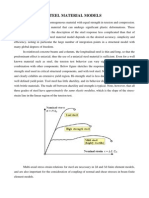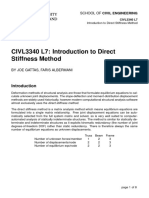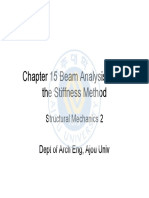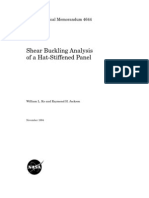Numerical Integration in Opensees
Uploaded by
17539890845Numerical Integration in Opensees
Uploaded by
17539890845Force-Based Element Integration Options in OpenSees
Michael H. Scott
Numerical Integration Options for the Force-Based Beam-Column Element in OpenSees
Michael H. Scott January 26, 2011
A wide range of numerical integration options are available in OpenSees to represent distributed plasticity or non-prismatic section details in force-based beam-column elements, i.e., across the entire element domain [0, L]. For the Tcl interpreter of OpenSees, there is a specic input format for each integration option that follows a common input format for the element tag, nodes, and transformation tags. The general form of the forceBeamColumn command is: set integration <specific integration arguments> element forceBeamColumn $tag $ndI $ndJ $transfTag $integration tag unique integer that will identify the element ndI/ndJ integer tag for node I /J of the element transfTag integer tag for geometric transformation type of the element integration string indicating the type of numerical integration for the element and the specic integration arguments, as described in the remainder of this document. Note: the OpenSees Tcl interpreter performs a recursive parse of this string so that integration parameters can be stored in a Tcl string variable.
Integration Methods for Distributed Plasticity
Distributed plasticity methods permit yielding at any integration point along the element length. Gauss-Lobatto Integration Gauss-Lobatto integration is the most common approach for evaluating the response of forcebased elements [3] because it places an integration point at each end of the element, where
Associate Professor, School of Civil and Construction Engineering, Oregon State University, Corvallis, OR, 97331, michael.scott@oregonstate.edu
Force-Based Element Integration Options in OpenSees bending moments are largest in the absence of interior element loads.
Michael H. Scott
set integration Lobatto $secTag $N element forceBeamColumn $tag $ndI $ndJ $transfTag $integration Places N Gauss-Lobatto integration points along the element. The location and weight of each integration point are tabulated in references on numerical analysis [1]. The forcedeformation response at each integration point is dened by the section with tag secTag. The order of accuracy for Gauss-Lobatto integration is 2N-3. Gauss-Legendre Integration Gauss-Legendre integration is more accurate than Gauss-Lobatto; however, it is not common in force-based elements because there are no integration points at the element ends. set integration Legendre $secTag $N element forceBeamColumn $tag $ndI $ndJ $transfTag $integration Places N Gauss-Legendre integration points along the element. The location and weight of each integration point are tabulated in references on numerical analysis [1]. The forcedeformation response at each integration point is dened by the section with tag secTag. The order of accuracy for Gauss-Legendre integration is 2N-1. Gauss-Radau Integration Gauss-Radau integration is not common in force-based elements because it places an integration point at only one end of the element; however, it forms the basis for optimal plastic hinge integration methods. set integration Radau $secTag $N element forceBeamColumn $tag $ndI $ndJ $transfTag $integration Places N Gauss-Radau integration points along the element with a point constrained to be at ndI. The location and weight of each integration point are tabulated in references on numerical analysis [1]. The force-deformation response at each integration point is dened by the section with tag secTag. The order of accuracy for Gauss-Radau integration is 2N-2. Newton-Cotes Integration Newton-Cotes places integration points uniformly along the element, including a point at each end of the element. set integration NewtonCotes $secTag $N
Force-Based Element Integration Options in OpenSees
Michael H. Scott
element forceBeamColumn $tag $ndI $ndJ $transfTag $integration Places N Newton-Cotes integration points along the element. The weights for the uniformly spaced integration points are tabulated in references on numerical analysis [1]. The forcedeformation response at each integration point is dened by the section with tag secTag. The order of accuracy for Gauss-Radau integration is N-1. Fixed Location Integration This option allows user-specied locations of the integration points. The associated integration weights are computed by the method of undetermined coecients (Vandermonde system). N 1 1 j 1 wi = xj 1 dx = xi (j = 1 , . . . , N ) (1) j 0 i=1 Note that Newton-Cotes integration is recovered when the integration point locations are equally spaced. set locations 0.0 0.2 0.5 0.8 1.0 set secTags 1 2 2 2 1 set integration FixedLocation $N $secTags $locations element forceBeamColumn $tag $ndI $ndJ $transfTag $integration Places N integration points along the element, whose locations are dened in a Tcl list locations on the natural domain [0, 1]. The force-deformation response at each integration point is dened by the sections with tags stored in the Tcl list secTags. Both the locations and secTags lists should be of length N. The order of accuracy for Fixed Location integration is N-1. Low Order Integration This option is a generalization of the Fixed Location and User Dened integration approaches and is useful for moving load analysis [2]. The locations of the integration points are userdened, while a selected number of weights are specied and the remaining weights are computed by the method of undetermined coecients.
Nf j 1 xf i wf i i=1
1 Nc j 1 x wci = j i=1 ci
(2)
Note that Fixed Location integration is recovered when Nc is zero. set locations 0.0 1.0 0.2 0.5 0.8 set weights 0.2 0.2 set secTags 1 1 2 2 2 3
Force-Based Element Integration Options in OpenSees
Michael H. Scott
set integration LowOrder $N $secTags $locations $weights element forceBeamColumn $tag $ndI $ndJ $transfTag $integration Places N integration points along the element, which are dened in the Tcl list locations on the natural domain [0, 1]. The force-deformation response at each integration point is dened by the section tags stored in the Tcl list secTags. Both the locations and secTags lists should be of length N. The weights at user-selected integration points are specied (on [0, 1]) in the weights list, which can be of length Nc equals 0 up to N. These specied weights are assigned to the rst Nc entries in the locations and secTags lists, respectively. The order of accuracy for Low Order integration is N-Nc-1. Note: Nc is determined from the length of the weights list. Accordingly, FixedLocation integration is recovered when weights is an empty list and UserDefined integration is recovered when the weights and locations lists are of equal length. Mid-Distance Integration This option allows user-specied locations of the integration points. The associated integration weights are determined from the midpoints between adjacent integration point locations. wi = (xi+1 xi1 )/2 for i = 2. . . N -1, w1 = (x1 + x2 )/2, and wN = 1 (xN 1 + xN )/2. set locations 0.1 0.2 0.5 0.8 0.9 set secTags 1 2 2 2 1 set integration MidDistance $N $secTags $locations element forceBeamColumn $tag $ndI $ndJ $transfTag $integration Places N integration points along the element, whose locations are dened in a Tcl list locations on the natural domain [0, 1]. The force-deformation response at each integration point is dened by the sections with tags stored in the Tcl list secTags. Both the locations and secTags lists should be of length N. This integration rule can only integrate constant functions exactly since the sum of the integration weights is one. For the locations shown above, the associated integration weights will be 0.15 0.2 0.3 0.2 0.15. User Dened Integration This option allows user-specied locations and weights of the integration points. set locations 0.1 0.3 0.5 0.7 0.9 set weights 0.2 0.15 0.3 0.15 0.2 set secTags 1 2 2 2 1 set integration UserDefined $N $secTags $locations $weights element forceBeamColumn $tag $ndI $ndJ $transfTag $integration
Force-Based Element Integration Options in OpenSees
Michael H. Scott
Places N integration points along the element, which are dened in the Tcl list locations on the natural domain [0, 1]. The weight of each integration point is dened in the Tcl list weights, also on the [0, 1] domain. The force-deformation response at each integration point is dened by the sections with tags stored in the Tcl list secTags. The locations, weights, and secTags lists should be of length N. In general, there is no accuracy for this approach to numerical integration.
Plastic Hinge Integration Methods
Plastic hinge integration methods conne material yielding to regions of the element of specied length while the remainder of the element is linear elastic. A summary of plastic hinge integration methods is found in [4]. Midpoint Hinge Integration Midpoint integration over each hinge region is the most accurate one-point integration rule; however, it does not place integration points at the element ends and there is a small integration error for linear curvature distributions along the element. set integration HingeMidpoint $secTagI $lpI $secTagJ $lpJ $secTagE element forceBeamColumn $tag $ndI $ndJ $transfTag $integration The plastic hinge length at end I (J) is equal to lpI (lpJ) and the associated forcedeformation response is dened by the section with tag secTagI (secTagJ). The forcedeformation response of the element interior is dened by the section with tag secTagE. Typically, the interior section is linear-elastic, but this is not necessary. Endpoint Hinge Integration Endpoint integration over each hinge region moves the integration points to the element ends; however, there is a large integration error for linear curvature distributions along the element. set integration HingeEndpoint $secTagI $lpI $secTagJ $lpJ $secTagE element forceBeamColumn $tag $ndI $ndJ $transfTag $integration The plastic hinge length at end I (J) is equal to lpI (lpJ) and the associated forcedeformation response is dened by the section with tag secTagI (secTagJ). The forcedeformation response of the element interior is dened by the section with tag secTagE. Typically, the interior section is linear-elastic, but this is not necessary. Radau Hinge Integration Two-point Gauss-Radau integration over each hinge region places an integration point at the element ends and at 2/3 the hinge length inside the element. This approach represents 5
Force-Based Element Integration Options in OpenSees
Michael H. Scott
linear curvature distributions exactly; however, the characteristic length for softening plastic hinges is not equal to the assumed palstic hinge length. set integration HingeRadauTwo $secTagI $lpI $secTagJ $lpJ $secTagE element forceBeamColumn $tag $ndI $ndJ $transfTag $integration The plastic hinge length at end I (J) is equal to lpI (lpJ) and the associated forcedeformation response is dened by the section with tag secTagI (secTagJ). The forcedeformation response of the element interior is dened by the section with tag secTagE. Typically, the interior section is linear-elastic, but this is not necessary. Modied Radau Hinge Integration Modied two-point Gauss-Radau integration over each hinge region places an integration point at the element ends and at 8/3 the hinge length inside the element. This approach represents linear curvature distributions exactly and the characteristic length for softening plastic hinges is equal to the assumed plastic hinge length. set integration HingeRadau $secTagI $lpI $secTagJ $lpJ $secTagE element forceBeamColumn $tag $ndI $ndJ $transfTag $integration The plastic hinge length at end I (J) is equal to lpI (lpJ) and the associated forcedeformation response is dened by the section with tag secTagI (secTagJ). The forcedeformation response of the element interior is dened by the section with tag secTagE. Typically, the interior section is linear-elastic, but this is not necessary.
Regularized Hinge Integration
If it is known a priori whether to use distributed plasticity integration for strain-hardening response or a plastic hinge method for strain-softening response, the regularized approach developed in [5] is suggested. set integration RegularizedHinge distType nIP? secTagI? lpI? zetaI? secTagJ? lpJ? zetaJ? secTagE? element forceBeamColumn $tag $ndI $ndJ $transfTag $integration The plastic hinge length at end I (J) is equal to lpI (lpJ) and the associated forcedeformation response is dened by the section with tag secTagI (secTagJ). The forcedeformation response of the element interior is dened by the section with tag secTagE. The distType argument is the underlying distributed plasticity integration approach, either Lobatto, Legendre, Radau, or NewtonCotes, with nIP integration points. The arguments zetaI and zetaJ indicate the distance inside the element ends (I and J , respectively) that additional integration points are located in order to enforce numerical consistency in 6
Force-Based Element Integration Options in OpenSees
Michael H. Scott
the case of strain-hardening response. Typical values for zetaI and zetaJ range from 0.1% to 1.0% of the element length. Further information on this nal group of arguments can be found in [5].
References
[1] M. Abramowitz and C. A. Stegun, editors. Handbook of Mathematical Functions with Formulas, Graphs, and Mathematical Tables. Dover, New York, NY, 9th edition, 1972. [2] A. Kidarsa, M. H. Scott, and C. C. Higgins. Analysis of moving loads using force-based nite elements. Finite Elements in Analysis and Design, 44(4):214224, 2008. [3] A. Neuenhofer and F. C. Filippou. Evaluation of nonlinear frame nite-element models. Journal of Structural Engineering, 123(7):958966, July 1997. [4] M. H. Scott and G. L. Fenves. Plastic hinge integration methods for force-based beamcolumn elements. Journal of Structural Engineering, 132(2):244252, February 2006. [5] M. H. Scott and O. M. Hamutcuoglu. Numerically consistent regularization of forcebased frame elements. International Journal for Numerical Methods in Engineering, 76(10):16121631, 2008.
You might also like
- Mathcad - 2019 SDOF Plane Frame Model Dynamic AnalysisNo ratings yetMathcad - 2019 SDOF Plane Frame Model Dynamic Analysis12 pages
- Geotechnical Elements and Models in OpenSeesNo ratings yetGeotechnical Elements and Models in OpenSees21 pages
- Cee-576 Nonlinear Finite Elements (Same As CSE-552)No ratings yetCee-576 Nonlinear Finite Elements (Same As CSE-552)3 pages
- CE 809 - Lecture 6 - Response of SDF Systems To General Dynamic LoadingNo ratings yetCE 809 - Lecture 6 - Response of SDF Systems To General Dynamic Loading45 pages
- 3-D Finite Element Modeling in OpenSees For Bridge - Scoggins - Thesis100% (2)3-D Finite Element Modeling in OpenSees For Bridge - Scoggins - Thesis54 pages
- DTD Handbook: Section 2.2.6.3. Crack Opening DisplacementNo ratings yetDTD Handbook: Section 2.2.6.3. Crack Opening Displacement4 pages
- Opensees-Snopt: Framework For Finite Element Based OptimizationNo ratings yetOpensees-Snopt: Framework For Finite Element Based Optimization68 pages
- Sources of Elastic Deformation in Steel Frame and Framed-Tube Structures: Part 1: Simplified Subassemblage ModelsNo ratings yetSources of Elastic Deformation in Steel Frame and Framed-Tube Structures: Part 1: Simplified Subassemblage Models14 pages
- Dynamic Response of Bridges Under Travelling LoadsNo ratings yetDynamic Response of Bridges Under Travelling Loads12 pages
- Beams With Corrugated Web at Elevated Temperature Exp 2016 Thin Walled StruNo ratings yetBeams With Corrugated Web at Elevated Temperature Exp 2016 Thin Walled Stru10 pages
- Sapkas & Kollar - Lateral-Torsional Buckling of Composite Beams (2002)No ratings yetSapkas & Kollar - Lateral-Torsional Buckling of Composite Beams (2002)25 pages
- MacNeal & Harder - Standard Problems FE AccuracyNo ratings yetMacNeal & Harder - Standard Problems FE Accuracy18 pages
- BD-3.7.13 - PACT Beta Test Overview Buildings A, B, C PDFNo ratings yetBD-3.7.13 - PACT Beta Test Overview Buildings A, B, C PDF12 pages
- Behavior of Interior Beam-to-Column Connections UnderNo ratings yetBehavior of Interior Beam-to-Column Connections Under7 pages
- Study of The SPH Method For Simulation in LS-Dyna: Tran Thanh TungNo ratings yetStudy of The SPH Method For Simulation in LS-Dyna: Tran Thanh Tung4 pages
- The Theory of Momentless Shells of Revolution, V.Z. VlasovNo ratings yetThe Theory of Momentless Shells of Revolution, V.Z. Vlasov38 pages
- Lateral Torsional Buckling Behaviour of Steel BeamsNo ratings yetLateral Torsional Buckling Behaviour of Steel Beams19 pages
- 14.beam Analysis Using The Stiffness MethodNo ratings yet14.beam Analysis Using The Stiffness Method23 pages
- Static Analysis of Timoshenko Beams Using Isogeometric ApproachNo ratings yetStatic Analysis of Timoshenko Beams Using Isogeometric Approach9 pages
- Effect of Lateral Load Patterns in Pushover Analysis: November 2009No ratings yetEffect of Lateral Load Patterns in Pushover Analysis: November 20096 pages
- Design of Thi and Gant:) ' Structure Requi Es B Sic of Both Sta Ics and Dynamics. WH CH The Subject Engineering Mechanil::SNo ratings yetDesign of Thi and Gant:) ' Structure Requi Es B Sic of Both Sta Ics and Dynamics. WH CH The Subject Engineering Mechanil::S3 pages
- DO-DOHL-PD-CHK-0003-14 Rev0 (Finite Element Analysis Checklist)No ratings yetDO-DOHL-PD-CHK-0003-14 Rev0 (Finite Element Analysis Checklist)2 pages
- Theory of Structural Stability (CET-308)No ratings yetTheory of Structural Stability (CET-308)52 pages
- Finite Element Analysis of Shell StructuresNo ratings yetFinite Element Analysis of Shell Structures59 pages
- IDARC 2D Version 4.0 A Program For The Inelastic Damage Analysis of BuildingsNo ratings yetIDARC 2D Version 4.0 A Program For The Inelastic Damage Analysis of Buildings206 pages
- Damage Mechanics in Metal Forming: Advanced Modeling and Numerical SimulationFrom EverandDamage Mechanics in Metal Forming: Advanced Modeling and Numerical Simulation4/5 (1)
- A Catalogue of Details on Pre-Contract Schedules: Surgical Eye Centre of Excellence - KathFrom EverandA Catalogue of Details on Pre-Contract Schedules: Surgical Eye Centre of Excellence - KathNo ratings yet
- Probabilistic service life model of RC structures subjected to the combined effect of chloride-induced corrosion and cyclic loadingFrom EverandProbabilistic service life model of RC structures subjected to the combined effect of chloride-induced corrosion and cyclic loadingNo ratings yet
- Methodologies for Seismic Safety Evaluation of Existing Nuclear InstallationsFrom EverandMethodologies for Seismic Safety Evaluation of Existing Nuclear InstallationsNo ratings yet
- Accuracy and Efficiency of Simplified Tensor Network CodesNo ratings yetAccuracy and Efficiency of Simplified Tensor Network Codes14 pages
- A Global-Local Optimization Method For Problems in Structural DynamicsNo ratings yetA Global-Local Optimization Method For Problems in Structural Dynamics10 pages
- 01 Lal Kitab Concept - Posheeda Teen - Veiled Trio100% (3)01 Lal Kitab Concept - Posheeda Teen - Veiled Trio3 pages
- Psychological Hermeneutics for Biblical Themes and Text 1st Edition J. Harold Ellens 2024 Scribd Download100% (1)Psychological Hermeneutics for Biblical Themes and Text 1st Edition J. Harold Ellens 2024 Scribd Download77 pages
- Advanced Masterclass CAE Student's Book PDF100% (4)Advanced Masterclass CAE Student's Book PDF209 pages
- Hilcoe School of Computer Science and Technology: Meron Teshome / Am9943No ratings yetHilcoe School of Computer Science and Technology: Meron Teshome / Am994314 pages
- R - 04 X 1.PGM - Oxi Programming ExampleNo ratings yetR - 04 X 1.PGM - Oxi Programming Example7 pages
- DP90 and Message "No Expenditure Items Found": SymptomNo ratings yetDP90 and Message "No Expenditure Items Found": Symptom2 pages
- For (Var Startvalue Var Endvalue Var Var+increment) (Code To Be ExecutedNo ratings yetFor (Var Startvalue Var Endvalue Var Var+increment) (Code To Be Executed8 pages
- Unlocking Language Strategies For Teaching English As A Foreign LanguageNo ratings yetUnlocking Language Strategies For Teaching English As A Foreign Language10 pages
- A.1.3 Philippine Literary History - American PeriodNo ratings yetA.1.3 Philippine Literary History - American Period43 pages
- baixardoc.com-jyotishvedic-astrology-secret-revealed-kaal-purusha (1)No ratings yetbaixardoc.com-jyotishvedic-astrology-secret-revealed-kaal-purusha (1)10 pages
- Mathcad - 2019 SDOF Plane Frame Model Dynamic AnalysisMathcad - 2019 SDOF Plane Frame Model Dynamic Analysis
- Cee-576 Nonlinear Finite Elements (Same As CSE-552)Cee-576 Nonlinear Finite Elements (Same As CSE-552)
- CE 809 - Lecture 6 - Response of SDF Systems To General Dynamic LoadingCE 809 - Lecture 6 - Response of SDF Systems To General Dynamic Loading
- 3-D Finite Element Modeling in OpenSees For Bridge - Scoggins - Thesis3-D Finite Element Modeling in OpenSees For Bridge - Scoggins - Thesis
- DTD Handbook: Section 2.2.6.3. Crack Opening DisplacementDTD Handbook: Section 2.2.6.3. Crack Opening Displacement
- Opensees-Snopt: Framework For Finite Element Based OptimizationOpensees-Snopt: Framework For Finite Element Based Optimization
- Sources of Elastic Deformation in Steel Frame and Framed-Tube Structures: Part 1: Simplified Subassemblage ModelsSources of Elastic Deformation in Steel Frame and Framed-Tube Structures: Part 1: Simplified Subassemblage Models
- Dynamic Response of Bridges Under Travelling LoadsDynamic Response of Bridges Under Travelling Loads
- Beams With Corrugated Web at Elevated Temperature Exp 2016 Thin Walled StruBeams With Corrugated Web at Elevated Temperature Exp 2016 Thin Walled Stru
- Sapkas & Kollar - Lateral-Torsional Buckling of Composite Beams (2002)Sapkas & Kollar - Lateral-Torsional Buckling of Composite Beams (2002)
- BD-3.7.13 - PACT Beta Test Overview Buildings A, B, C PDFBD-3.7.13 - PACT Beta Test Overview Buildings A, B, C PDF
- Behavior of Interior Beam-to-Column Connections UnderBehavior of Interior Beam-to-Column Connections Under
- Study of The SPH Method For Simulation in LS-Dyna: Tran Thanh TungStudy of The SPH Method For Simulation in LS-Dyna: Tran Thanh Tung
- The Theory of Momentless Shells of Revolution, V.Z. VlasovThe Theory of Momentless Shells of Revolution, V.Z. Vlasov
- Lateral Torsional Buckling Behaviour of Steel BeamsLateral Torsional Buckling Behaviour of Steel Beams
- Static Analysis of Timoshenko Beams Using Isogeometric ApproachStatic Analysis of Timoshenko Beams Using Isogeometric Approach
- Effect of Lateral Load Patterns in Pushover Analysis: November 2009Effect of Lateral Load Patterns in Pushover Analysis: November 2009
- Design of Thi and Gant:) ' Structure Requi Es B Sic of Both Sta Ics and Dynamics. WH CH The Subject Engineering Mechanil::SDesign of Thi and Gant:) ' Structure Requi Es B Sic of Both Sta Ics and Dynamics. WH CH The Subject Engineering Mechanil::S
- DO-DOHL-PD-CHK-0003-14 Rev0 (Finite Element Analysis Checklist)DO-DOHL-PD-CHK-0003-14 Rev0 (Finite Element Analysis Checklist)
- IDARC 2D Version 4.0 A Program For The Inelastic Damage Analysis of BuildingsIDARC 2D Version 4.0 A Program For The Inelastic Damage Analysis of Buildings
- Damage Mechanics in Metal Forming: Advanced Modeling and Numerical SimulationFrom EverandDamage Mechanics in Metal Forming: Advanced Modeling and Numerical Simulation
- A Catalogue of Details on Pre-Contract Schedules: Surgical Eye Centre of Excellence - KathFrom EverandA Catalogue of Details on Pre-Contract Schedules: Surgical Eye Centre of Excellence - Kath
- Probabilistic service life model of RC structures subjected to the combined effect of chloride-induced corrosion and cyclic loadingFrom EverandProbabilistic service life model of RC structures subjected to the combined effect of chloride-induced corrosion and cyclic loading
- Methodologies for Seismic Safety Evaluation of Existing Nuclear InstallationsFrom EverandMethodologies for Seismic Safety Evaluation of Existing Nuclear Installations
- Accuracy and Efficiency of Simplified Tensor Network CodesAccuracy and Efficiency of Simplified Tensor Network Codes
- A Global-Local Optimization Method For Problems in Structural DynamicsA Global-Local Optimization Method For Problems in Structural Dynamics
- 01 Lal Kitab Concept - Posheeda Teen - Veiled Trio01 Lal Kitab Concept - Posheeda Teen - Veiled Trio
- Psychological Hermeneutics for Biblical Themes and Text 1st Edition J. Harold Ellens 2024 Scribd DownloadPsychological Hermeneutics for Biblical Themes and Text 1st Edition J. Harold Ellens 2024 Scribd Download
- Hilcoe School of Computer Science and Technology: Meron Teshome / Am9943Hilcoe School of Computer Science and Technology: Meron Teshome / Am9943
- DP90 and Message "No Expenditure Items Found": SymptomDP90 and Message "No Expenditure Items Found": Symptom
- For (Var Startvalue Var Endvalue Var Var+increment) (Code To Be ExecutedFor (Var Startvalue Var Endvalue Var Var+increment) (Code To Be Executed
- Unlocking Language Strategies For Teaching English As A Foreign LanguageUnlocking Language Strategies For Teaching English As A Foreign Language
- A.1.3 Philippine Literary History - American PeriodA.1.3 Philippine Literary History - American Period
- baixardoc.com-jyotishvedic-astrology-secret-revealed-kaal-purusha (1)baixardoc.com-jyotishvedic-astrology-secret-revealed-kaal-purusha (1)






























































































